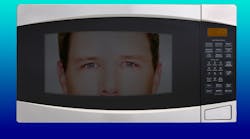Beware—the Microwave May be Listening!
Surveillance has played a prominent role in successful military campaigns, but less so in political campaigns—although members of the current U.S. administration may beg to differ. News reports of wiretapped phone lines and microwave ovens used as listening devices suggest an uncomfortable level of paranoia in the executive branch, not to mention a disquieting disconnect from the realities of modern RF/wireless technologies.
Microwave ovens probably represent the first encounter with microwave technology for most people. For many, they are the means to a warm lunch or dinner and a quick way to warm that forgotten cup of coffee. These appliances operate at a frequency of about 2.45 GHz by means of dielectric heating effects, essentially energizing the water molecules within the food or liquid to be heated. Microwave ovens were once almost entirely based on vacuum tube electronic devices, although more recent versions make use of solid-state devices (such as GaN HEMTs) to provide the microwave power.
Traditional military electronic surveillance involves the search for a signal, whether it be from an adversary’s radio or radar transmitter, or even its electronic-warfare (EW) system. In the simplest context, surveillance is listening to a conversation while silent and hidden, so that the participants of the conversation are unaware that another party is listening.
Performing surveillance requires some kind of tracking or listening device, like a wireless microphone hidden in a room. Or, if left unattended and unnoticed, the microphone embedded in a laptop computer could provide similar engress. Using popular wireless technologies such as Bluetooth or Wi-Fi, either example could be used for simple audio surveillance, transmitting a digital version of the “wiretapped” conversation to an unseen listener.
Image courtesy of Thinkstock
Could a microwave oven operate as a surveillance device? Possibly…if it’s properly equipped. As mentioned above, a microwave oven operates at 2.45 GHz—coincidentally, in the same unlicensed Industrial, Scientific, and Medical (ISM) frequency range as Bluetooth and Wi-Fi. But it is not modulated for communications purposes, such as the advanced modulation and frequency-hopping spread spectrum techniques that allow multiple Bluetooth devices to operate effectively in the same room without interfering with (or listening to) each other.
A microwave oven could potentially operate as a transmitter, if modulated and if connected to an antenna. But if so, what information would it be sending in the transmission? Listening or surveillance implies a receiver or, at the very least, a microphone to capture audio. Certainly, a microwave oven could be designed as a listening device, with integrated microphones and receivers. But such devices would be competing with a relatively large EM field within the microwave oven. Under normal circumstances, that field is effectively shielded to prevent interference with more traditional wireless communications devices in the ISM band.
Certainly, a microwave oven could be designed for surveillance (as well as for cooking). It would be possible to integrate low-profile planar antennas into the microwave oven enclosure, along with cameras and microphones made to look like part of the cabinet design. Low-cost wireless transceiver ICs are also available that could be integrated into a microwave oven cabinet to enable access to any captured audio and video information. This could be achieved without attempting to make use of the microwave oven’s vacuum-tube or solid-state energy source as a transmitter (which would have to be modulated for communications purposes).
However, this is not the type of microwave oven that one is likely to find at a local Sears, or even at the White House. While this may be the form of “wiretapping” that members of the executive branch have detailed recently in the press, it is highly unlikely that any listening was being done through a microwave oven. If anything, the unlicensed communications standards in the same frequency band, such as Bluetooth and Wi-Fi, are totally without security in terms of surveillance activities
In all likelihood, were any listening being done, it was by means of an ISM-band communications link. As noted, an unattended laptop computer with built-in microphones, cameras, and a Wi-Fi transceiver has the potential to perform surveillance wherever access to a Wi-Fi connection can be found.
The new president and executive branch may have raised expectations with regard to jobs creation and investment in military technologies, but they have a bit to learn about wireless and microwave technologies. Remember, it takes a receiver to “listen,” but it takes a transmitter to keep the dinner warm.


